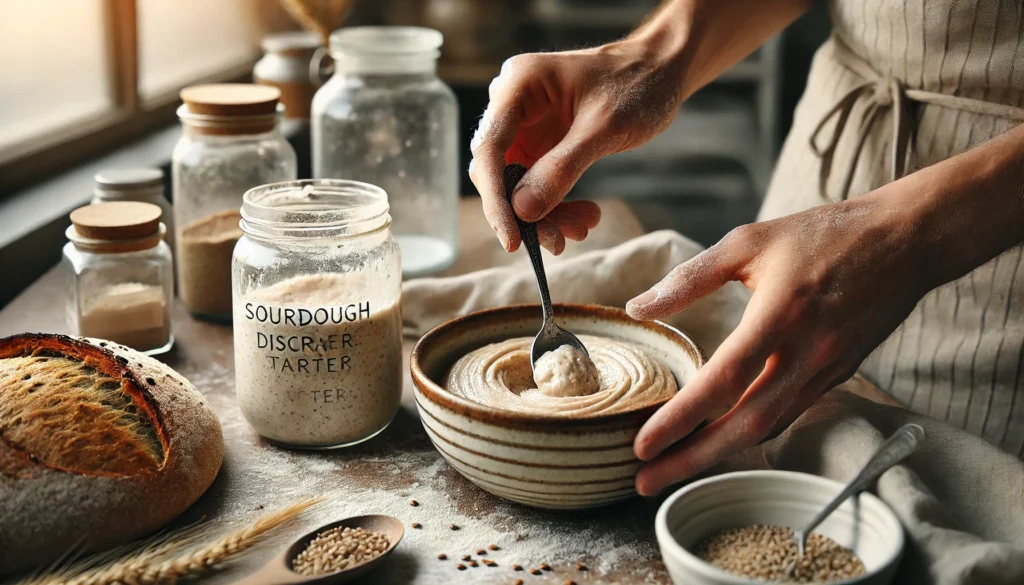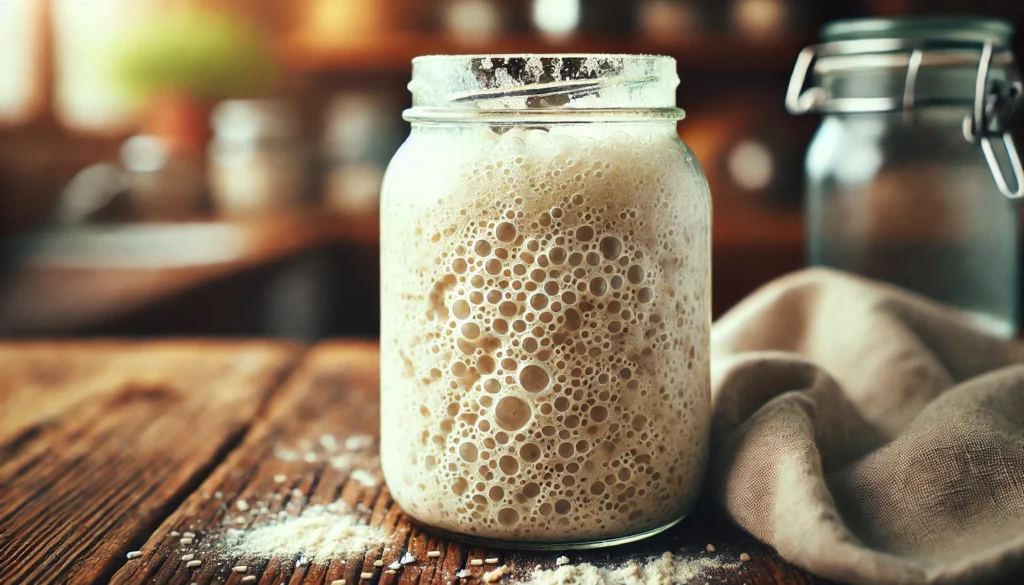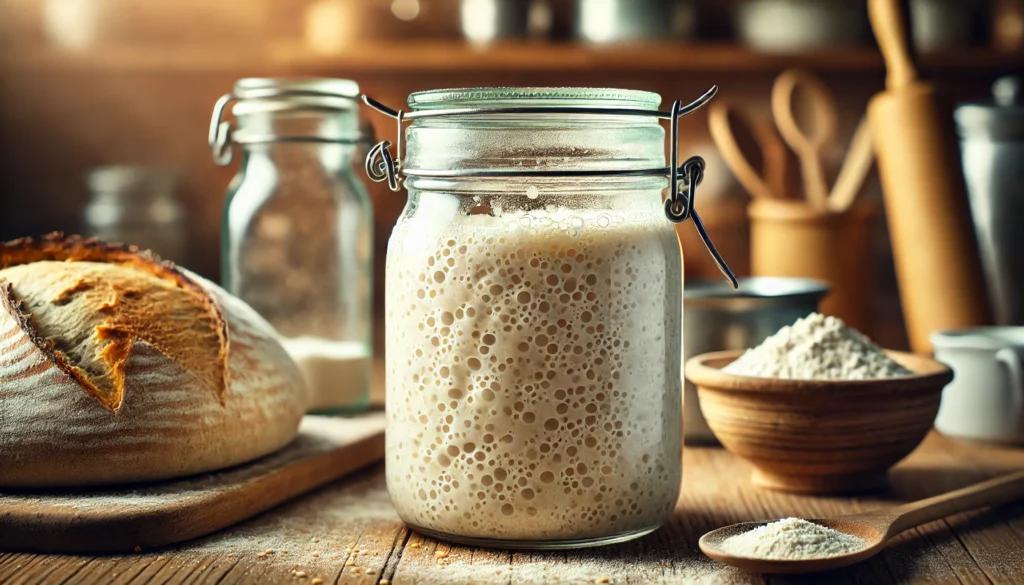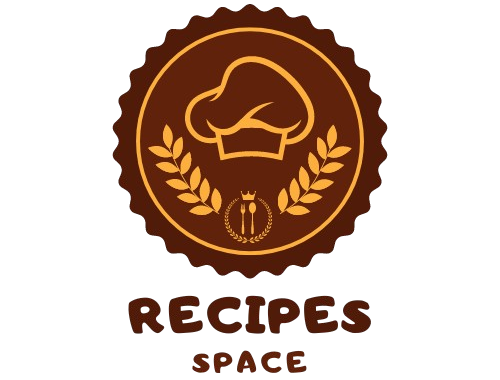Sourdough baking has become popular for its unique flavor and health benefits. If you’re new to sourdough, you might wonder: What is the difference between sourdough starter and discard? Understanding these two components is crucial for any baker looking to perfect their sourdough skills. This article explores the differences between a sourdough starter and sourdough discard, explaining their roles in baking and how to use each effectively.

What is a Sourdough Starter?
A sourdough starter is a mix of flour and water that ferments over time, allowing wild yeast and lactic acid bacteria to grow. This starter acts as a natural leavening agent, giving sourdough bread its rise and characteristic tangy flavor.

To create a starter, you mix equal parts of flour and water and let the mixture sit at room temperature. The wild yeast and bacteria from the environment and the flour begin to ferment, creating bubbles and a slightly sour smell. To keep the starter alive, you need to “feed” it regularly with fresh flour and water. This feeding ensures that the yeast and bacteria continue to thrive.
For more details on using sourdough discard and its various applications, check out What Can You Do with Sourdough Discard?.
What is Sourdough Discard?
Sourdough discard is the portion of the starter that you remove before feeding it. When you maintain a sourdough starter, you typically remove a portion to keep its size manageable and to refresh its food source with fresh flour and water. This removed portion is known as the discard because people often throw it away, but you can also use it in a variety of recipes.

While sourdough discard does not have the same leavening power as the active starter, it still contains wild yeast and bacteria. This gives it a tangy flavor and some probiotic benefits. Learn more about the differences between sourdough starter and discard and how they affect your baking.
Key Differences Between Sourdough Starter and Discard
Understanding the key differences between sourdough starter and discard is essential for utilizing each properly in your baking:
- Purpose: The sourdough starter serves as a leavening agent, providing the lift for sourdough bread. In contrast, the discard is a byproduct of maintaining the starter and does not typically function as a leavening agent.
- Fermentation Activity: The starter contains active wild yeast and bacteria, which are essential for fermentation. The discard, however, has less yeast activity because it is not fed and maintained like the starter. This difference affects how each is used in baking recipes.
- Usage in Recipes: A sourdough starter is ideal for making bread and other leavened products, where its ability to rise is crucial. On the other hand, sourdough discard works best in recipes that do not require rising, such as pancakes, waffles, crackers, and some cakes and cookies.
- Nutritional Content: Both the starter and discard contain beneficial microorganisms. However, the starter has a more active culture, offering potentially greater probiotic benefits. Discard still adds a tangy flavor and some nutritional benefits, but not to the same extent as a fresh, active starter.
For more details on storing sourdough discard and maintaining its quality, visit our guide on How Long Is Sourdough Discard Good For?.
How to Use Sourdough Starter and Discard in Baking
Both sourdough starter and discard have their place in the kitchen, each offering unique benefits:
- Using Sourdough Starter: The active starter is best for recipes that require a rise, such as sourdough bread, bagels, and pizza dough. The fermentation process helps the dough rise and gives it a unique sour flavor.
- Using Sourdough Discard: The discard works well in recipes that don’t need the rising power of yeast, like pancakes, waffles, crackers, and quick breads. Using discard in these recipes adds a subtle tang and helps reduce waste.
For more creative uses of sourdough discard in various recipes, check out The Ultimate Guide to Sourdough Discard Recipes.
Storing and Maintaining Sourdough Starter and Discard
Proper storage is crucial to maintain the health of your sourdough starter and keep your discard usable:
- Storing a Sourdough Starter: Store your starter in a jar at room temperature if you plan to use it frequently. For less frequent use, store it in the refrigerator and feed it weekly to keep it active.
- Storing Sourdough Discard: Keep your discard in a sealed container in the refrigerator. It can last for about a week, but check for any signs of spoilage, such as mold or an off smell. You can also freeze discard in an airtight container for up to three months, extending its usability.
Benefits and Drawbacks of Using Sourdough Starter vs. Discard
Both components have their advantages and drawbacks:
- Benefits of Using Starter: Provides a rich, authentic sourdough flavor and texture, with health benefits from the natural fermentation process.
- Drawbacks of Using Starter: Requires regular maintenance and feeding, which can be time-consuming and needs planning for consistent use.
- Benefits of Using Discard: Helps reduce waste, versatile in various recipes, and imparts a mild sour flavor without needing fermentation.
- Drawbacks of Using Discard: Lacks the leavening power of an active starter and may have a different flavor profile that’s less potent than the fully active starter.
FAQs About Sourdough Starter and Discard
What can I use sourdough discard for?
Use sourdough discard in recipes that don’t need rising, such as pancakes, waffles, crackers, and muffins. It adds flavor and reduces waste.
How often should I feed my sourdough starter?
Feed your starter daily if kept at room temperature or weekly if stored in the refrigerator to maintain its activity.
Can sourdough discard be used for bread?
No, discard lacks the leavening power needed for bread. It works best in non-leavened recipes.
What happens if I use sourdough discard instead of starter?
Using discard instead of starter in bread results in a denser texture and lacks a proper rise due to lower yeast activity in discard.
How long can sourdough discard be kept?
Sourdough discard can be stored in the refrigerator for up to a week or in the freezer for up to three months.
Conclusion
Understanding the difference between sourdough starter and discard allows you to use each component effectively in your baking. Whether you’re crafting the perfect loaf of sourdough bread or finding creative ways to use your discard, both have valuable roles in the kitchen. Experiment with both to enhance your baking skills and reduce waste, making the most out of your sourdough journey.
